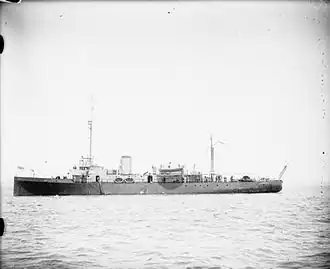HMS Kinross
 Sister ship to HMS Kinross, HMS Aberdare in 1919
| |
| History | |
|---|---|
| Name | Kinross |
| Builder | Fairfield Shipbuilding and Engineering Company |
| Yard number | 576 |
| Launched | 4 July 1918 |
| Out of service | 16 June 1919 |
| Fate | Sunk by mine 16 June 1919 in the Aegean Sea[1] |
| General characteristics | |
| Class & type | Hunt-class minesweeper, Aberdare sub-class |
| Displacement | 800 long tons (813 t) |
| Length | 213 ft (64.9 m) o/a |
| Beam | 28 ft 6 in (8.7 m) |
| Draught | 7 ft 6 in (2.3 m) |
| Installed power |
|
| Propulsion | 2 shafts; 2 triple-expansion steam engines |
| Speed | 16 knots (30 km/h; 18 mph) |
| Range | 1,500 nmi (2,800 km; 1,700 mi) at 15 knots (28 km/h; 17 mph) |
| Complement | 74 |
| Armament |
|
HMS Kinross was a Hunt-class minesweeper built for the Royal Navy during World War I. Completed in 1918, the ship was sunk after striking a mine the following year.
Design and description
The Aberdare sub-class were enlarged versions of the original Hunt-class ships with a more powerful armament. The ships displaced 750 long tons (760 t) at normal load[2] and 930 long tons (940 t) at full load.[3] They measured 231 feet (70.4 m) long overall with a beam of 28 feet 6 inches (8.7 m) and a draught of 7 feet 6 inches (2.3 m). The ships' complement consisted of 74 officers and ratings.[2]
The ships had two vertical triple-expansion steam engines, each driving one shaft using steam provided by two Yarrow boilers. The engines produced a total of 2,200 indicated horsepower (1,600 kW) and gave a maximum speed of 16 knots (30 km/h; 18 mph). They carried a maximum of 185 long tons (188 t) of coal[2] which gave them a range of 1,500 nautical miles (2,800 km; 1,700 mi) at 15 knots (28 km/h; 17 mph).[4]
The Aberdare sub-class was armed with a quick-firing (QF) four-inch (102 mm) gun forward of the bridge and a QF twelve-pounder (3-inch (76.2 mm)) anti-aircraft gun aft.[2] Some ships were fitted with QF six-pounder (2.2-inch (57 mm)) Hotchkiss guns or QF three-pounder (1.5-inch (37 mm)) Hotchkiss guns in lieu of the twelve-pounder.[4]
Construction and career
Kinross, the first ship of her name in the Royal Navy, was built by Fairfield Shipbuilding and Engineering Company at their shipyard in Govan, Scotland. The ship was launched on 4 July 1918. She struck a mine in the Aegean Sea and sank on 16 June 1919.[5]
Citations
Bibliography
- Cocker, M. P. (1993). Mine Warfare Vessels of the Royal Navy: 1908 to Date. Airlife Publishing. ISBN 1-85310-328-4.
- Colledge, J. J.; Warlow, Ben & Bush, Steve (2020). Ships of the Royal Navy: The Complete Record of all Fighting Ships of the Royal Navy from the 15th Century to the Present (5th revised and updated ed.). Seaforth Publishing. ISBN 978-1-5267-9327-0.
- Lenton, H. T. (1998). British & Empire Warships of the Second World War. Naval Institute Press. ISBN 1-55750-048-7.
- Preston, Antony (1985). "Great Britain and Empire Forces". In Gray, Randal (ed.). Conway's All the World's Fighting Ships 1906–1921. Naval Institute Press. pp. 1–104. ISBN 0-85177-245-5.